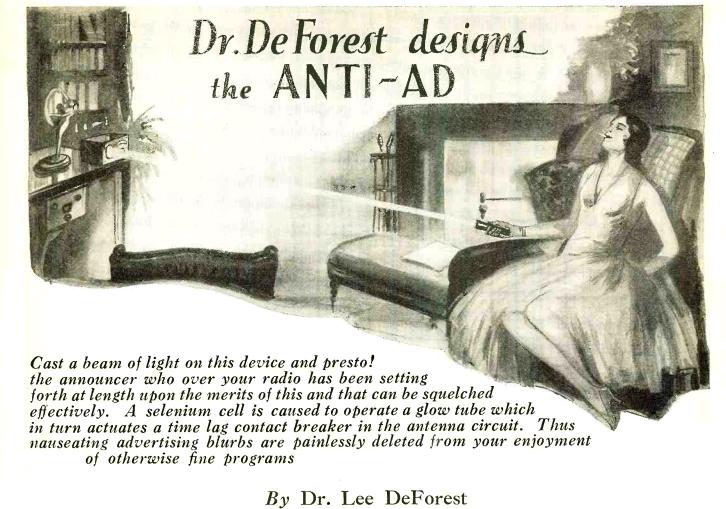Dr. Lee DeForest is, of course, best known as the inventor of the audion, or triode tube. But he had many other inventions to his credit. For example, a few months ago, we featured the 1950’s Arizona fallout shelter/ham shack of William A. Rhodes, W7PYH (later W7KLA). It turns out that DeForest was co-inventor along with Rhodes of an electronic light amplifier with applications in astronomy and television.
And 85 years ago, we see what some might consider to be DeForest’s greatest invention, the “ANTI-AD,” a remote control device for squelching annoying radio advertisements. DeForest describes the device in the September 1930 issue of Radio News, wherein he laments “the tendency of the present radio broadcast programs to degenerate more and more into crass commercialism and to devote a steadily indreasing proportion of the time to exploiting the merits of every conceivable commondity from tooth-paste and cigarettes to household furniture and diamond rings.”
While remote control sets were coming onto the market, DeForest notes that they came with the nuisance of having a cable between the radio and the easy chair, over which “the missus and the children invariably trip.”
Instead, DeForest came up with the entirely wireless solution to the problem. The radio’s antenna lead is connected to the device shown here, which contains a selenium cell, one tube, and a relay. When the offending commercial interrupts the program, the listener simply shines a small flashlight, “which can be had in very ornamental form” at the device. When the light hits the photocell, the antenna is disconnected and the radio silenced. The relay had a time delay which could be set to correspond to a typical commercial length.
“When the announcer begins to tell the health benefits of his cigarette,” the listener simply gives the unit a quick flash, knowing that at the approximate end of the commercial, the device will reset and the program resume.
DeForest concludes that the “Anti-Ad adds to real radio enjoyment and greatly extends the number of hours throughout the month when the radio set is in operation. It should therefore be received with open arms by the entire radio industry.” But perhaps it wasn’t, since ten years later, he wrote in an open letter to the National Association of Broadcasters: “What have you done with my child, the radio broadcast? You have debased this child, dressed him in rags of ragtime, tatters of jive and boogie-woogie.”
Click Here For Today’s Ripley’s Believe It Or Not Cartoon
![]()

